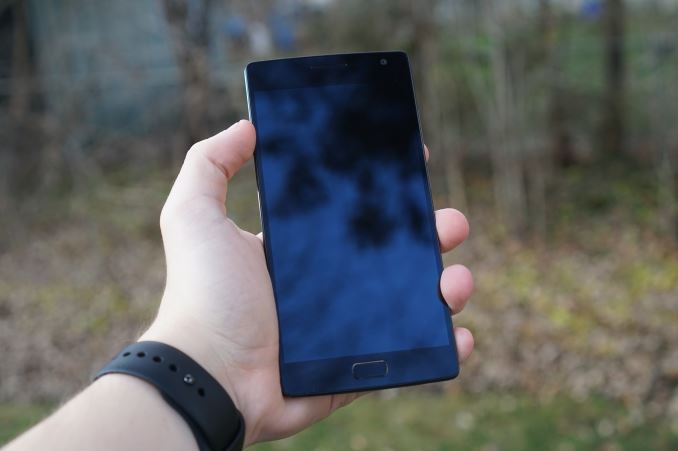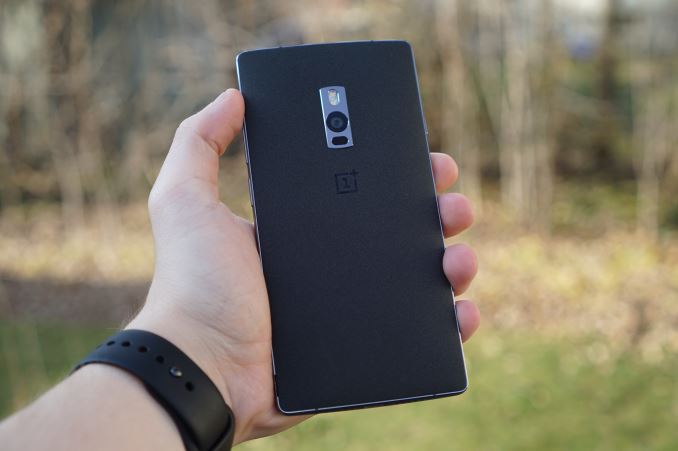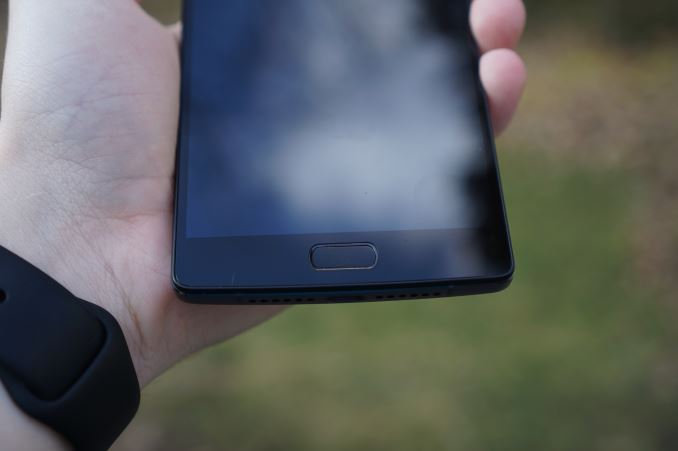The OnePlus 2 Review
by Brandon Chester on December 14, 2015 8:00 AM EST- Posted in
- Smartphones
- Mobile
- OnePlus
- OnePlus 2

In early 2014, there was a lot of excitement among Android enthusiasts for an upcoming smartphone called the OnePlus One. The company producing it was a Chinese manufacturer, and they were a new entrant to the smartphone space. OnePlus's marketing campaign was structured to generate excitement over the prospect of receiving similar specifications to a high end smartphone in a device that was priced substantially lower. Once the device launched, it was clear that OnePlus had delivered on that promise in many respects. The performance and display quality were superb for a $300-350 device, but parts of the software and the camera processing were somewhat lacking.
While the OnePlus One wasn't perfect, there really aren't any smartphones that are. For $300-350, it certainly offered users shopping on a budget a lot of power for their money. With many aspects of the phone already being executed well, one would expect that OnePlus's next phone would serve to iron out the issues and improve on some of the original's failings. That brings us to 2015, with the OnePlus 2 serving as the next flagship smartphone from OnePlus. In many ways it's similar to its predecessor, but with over a year between releases, and a change from CyanogenMod to OnePlus's Oxygen OS, there are certainly a number of changes as well. You can view a comparison of the OnePlus One and OnePlus 2 in the chart below.
| OnePlus One | OnePlus 2 | |
| SoC | Snapdragon 801 2.5 GHz Krait | Snapdragon 810 1.8 GHz A57/A53 |
| RAM | 3GB LPDDR3 | 3/4GB LPDDR4-1555 |
| NAND | 16/64GB NAND | 16/64GB NAND |
| Display | 5.5” 1080p IPS |
5.5” 1080p IPS |
| Network | 2G / 3G / 4G LTE (Category 4 LTE) | 2G / 3G / 4G LTE (Category 6/9 LTE) |
| Dimensions | 152.9 x 75.9 x 8.9mm, 162g | 151.8 x 74.9 x 9.85mm, 175g |
| Camera | 13MP Rear Facing (Sony IMX214) f/2.0, 1.1 micron 1/3.06" sensor | 13MP Rear Facing w/ OIS and laser AF, f/2.0, 1.3 micron 1/2.6" sensor |
| 5MP Front Facing | 5MP Front Facing | |
| Battery | 3200 mAh (12.16 Whr) | 3300 mAh (12.54 Whr) |
| OS | Android 4.4 w/ CM11S (At Launch) | Android 5.1 w/ OxygenOS (At Launch) |
| Connectivity | 1x1 802.11a/b/g/n/ac + BT 4.0 (WCN3680), USB2.0, GPS/GNSS, NFC |
802.11a/b/g/n/ac + BT 4.1, (QCA6164A) USB-C, GPS/GNSS |
| Fingerprint Sensor | N/A | Touch |
| SIM | 1x MicroSIM | DSDS NanoSIM |
| LTE Bands | Global: 1/3/4/7/17/38/40 | US: 1/2/4/5/7/8/12/17 EU: 1/3/5/7/8/20 |
| Launch Price | $299 (3GB/16GB) $349 (3GB/64GB) |
$329 (3GB/16GB) $389 (4GB/64GB) |
When looking at the specs of the OnePlus 2 one can definitely see a similarity between it and the OnePlus One. Both devices have 5.5" 1080p IPS displays, come with either 16 or 64GB of NAND, have a 13MP rear-facing camera with OIS, and ship with Qualcomm's latest SoC. In the case of the OnePlus 2, the SoC moves from Snapdragon 801 to 810, and with that we see a move to LPDDR4 DRAM along with an additional gigabyte of RAM in tow on the 64GB model. The battery capacity receives a slight bump as well, but this is also accompanied by an increase in mass and thickness. The camera sensor has been increased in size, from a 1/3.06" format to a 1/2.6" format. As for the other changes, there's improvement to both cellular and WiFi networking, the inclusion of a fingerprint scanner, and of course, a $30/40 increase in starting price for the 16/64GB models respectively.
Design
The OnePlus One had some unique design attributes that allowed it to stand out from the other devices on the market. Probably the most significant was the back cover, which sported a highly textured feel which one could describe as being like a very fine type of sandpaper. The OnePlus 2 retains many of these traits, but also adds to the design in other ways such as the use of metal for the frame around the device instead of plastic.
Starting with the back cover, you get the same sandpaper-like finish as the OnePlus One. The back cover is actually removable, but it's fit extremely well to the back of the device so you don't get highly visible seams. This means that it is a bit difficult to remove, and I had to slide a sim ejector between the one visible gap in order to start prying it off. While it is connected very tightly, the use of little plastic tabs to hold it on makes me a bit concerned about longevity if you remove the back cover too many times. The Galaxy Nexus used a similar mounting system and I recall seeing phones where one or two of the tabs had broken off which prevented it from attaching properly.
One you remove the back cover you'll see that you don't actually get a removable battery. This isn't any different from the OnePlus One, but I've never really understood the point of having a removable back that only serves to access the SIM tray, when you could just make the sim tray accessible from one of the edges of the device. Since the OnePlus 2 is a dual-SIM phone you also get an interesting little SIM tray which holds both SIM cards. I personally don't have much use for the dual-SIM feature, but I know there are certain (and major) markets where it's absolutely essential so it makes a great deal of sense for OnePlus to include it.
As for the appearance and feel of the back of the phone, I'm honestly not a huge fan. For me the textured back is interesting, but it's not really very pleasing to hold in the hand, and there's just something about how my palm rubs against it that gives me shivers. The little island for the camera, flash, and IR sensor also hasn't been designed with much thought. Considering the flash and IR sensor are almost the same size, I don't understand why OnePlus decided to put them in different orientations instead of making the entire arrangement symmetrical in its appearance. Something about the lack of edge space on the sides of the camera lens looks a bit off as well, although I find it difficult to articulate exactly why it seems that way.
On the bottom of the phone you'll find a set of drilled holes with a USB Type-C port sitting between them. I've said this in all of my other reviews of devices that use USB Type-C, but the transition has to happen eventually and while it's unfortunate that you won't be able to use existing Micro-B cables, it's worth it in the end.
Looking at the other sides of the phone one will see that the right side is home to the sleep/wake button and the volume rocker, while the left has a 3 stage mute switch. The three positions correspond to the three settings for Android notifications, and it's interesting that only OnePlus and Apple include a hardware switch to switch the mute status on their phones. The top of the phone is fairly featureless, aside from a 3.5mm audio jack.
Moving on to the front of the phone we find that it's dominated by the display, with minimal bezel on the top and bottom. Despite this, OnePlus has managed to implement capacitive buttons, a fingerprint scanner, and all without having to move the USB port such that it would be misaligned. The capacitive keys don't have any icons apart from an illuminated horizontal line, but by default they follow the same layout as the standard on screen keys that you'd find on other phones. On the top you have the earpiece and the front facing camera.
In the end, I think from a fit and finish standpoint the OnePlus 2 is actually a pretty good device. It does feel solid in the hand, there's no gaps or flex between the back cover and the rest of the phone due to how it attaches within the edges of the frame instead of onto them, and overall it just feels like a sturdy and substantial phone. As for the design, there are definitely some questionable choices that have been made such as the camera island on the back, and I am definitely not a fan of the back cover material. It's certainly unique though, and if you don't mind the back cover material you'll be getting a pretty solidly built device with the OnePlus 2.













132 Comments
View All Comments
LiverpoolFC5903 - Tuesday, December 15, 2015 - link
Sorry for sounding thick! So basically even though ALL the cores are operating synchronously, indvidual cores in a cluster can be into different power states and/or shut off altogether?How does this compare with something like a Snapdragon 801 where all 4 cores run at different frequencies depending on the workload?
phoenix_rizzen - Tuesday, December 15, 2015 - link
The cores in the S810 work the same way as in the S801.There's 3 ways that ARM's big.LITTLE setup works:
1. Cluster migration: either the A57 cluster is active, or the A53 cluster is active. The OS only ever sees 1 cluster of cores (so an S810 would appear as a 4-core SoC). This is done in hardware on the SoC itself.
2. Core migration: each A57 core is paired with an A53 core. Either the A57 or the A53 is active in each pair, never both at the same time. But an A57 from pair 1 can be active while an A53 from pair 2 is active, while the other two pairs are offline, for example. The OS only ever sees 1 cluster's worth of CPUs (so the S810 would appear as a quad-core). I believe this is done in hardware on the SoC itself.
3. Forget the name of this one, but all cores in all clusters are available for scheduling, and it's up to the OS to manage everything. 1 core can be online, 2 cores can be online, all the way up to all 8 cores can be online. And the kernel scheduler determines whether a process runs on an A53 core or an A57 core.
The first big.LITTLE SoCs from Samsung (the Exynos 54xx-something) used method 1. The latest big.LITTLE SoCs from everyone (Exynos 7xxx, Snapdragon 810/808, MediaTek Helios, etc) uses method 3.
LiverpoolFC5903 - Wednesday, December 16, 2015 - link
Thanks mate, but as Andrei pointed out, my question was a different one. But useful information all the same.Andrei Frumusanu - Tuesday, December 15, 2015 - link
Please ignore phoenix's comment, he seems to have misunderstood the question at hand.The Snapdragon 801 behaves as you say, they each have individual frequencies, meaning they're all on their own clock domain. Also each core has their own power domain, meaning each core can be individually turned off.
The difference again is that ARM CPUs such as the A57 in the S810 have all the same clock domain. However even if they all have the same clock they can still be individually powered off as the power domains are individual as well.
As to how it compares, it has both benefits and disadvantages. But there seems to be no clear winner.
LiverpoolFC5903 - Wednesday, December 16, 2015 - link
Thank you Andrei, its pretty clear to me now! Synchronous cores (A57, standard ARM cores) have the same clock domain which means cluster frequency remains the same. However, individual cores within each cluster can be powered off based on need and workloads.And Krait based quadcores have different clock domains for each core as well as different power domains.
Understood.
WoodyPWX - Tuesday, December 15, 2015 - link
Nice and honest review as always, thank you! A Lumia 950xl review would be awesome.victorson - Tuesday, December 15, 2015 - link
I love Anand and the insight in the reviews, but sometimes you guys throw something that even the more experienced reader will find hard to understand. "As always, all devices are calibrated to 200nits except when their brightness curves necessitate testing above that value." Could you kindly elaborate on what is that supposed to mean to those of us who are interested in display quality, but don't have a PhD on the matter? :)Ryan Smith - Tuesday, December 15, 2015 - link
As close to 200nits as we can get. If we can't hit 200 exactly, then it's the first value over that which we can hit.kasakka - Tuesday, December 15, 2015 - link
The sandstone black back cover is one of the best things about Oneplus phones. It really helps keeping a big phone like that firmly in your hands. By comparison the Oneplus X or iPhone 6S really needs a cover because they are very slippery.Where Oneplus went wrong with the Two was the Snapdragon 810 and that it's not that much of an upgrade from the One. As a One owner, the only things I'd like from it are LTE band 20, better speaker and vibration motor and the fingerprint reader which is positioned very poorly. On phones this size they should be in the back like on the Nexus phones because reaching down to that bottom area when using with one hand is quite annoying. I use the onscreen buttons on my One because of the same reason.
I really hope they manage a better design with the inevitable Oneplus Three. I like that they haven't jumped on the 1440p bandwagon because that doesn't really give any benefit in phones at this screen size. Just more pixels to push.
lid - Tuesday, December 15, 2015 - link
Thank you for providing LTE band information! It has always been a deciding factor for me, since I travel constantly. This phone doesn't seem great for anyone who frequently visits the EU from the US (since the US version is missing LTE band 3), or vice versa (since the EU version is missing LTE bands 2/4).